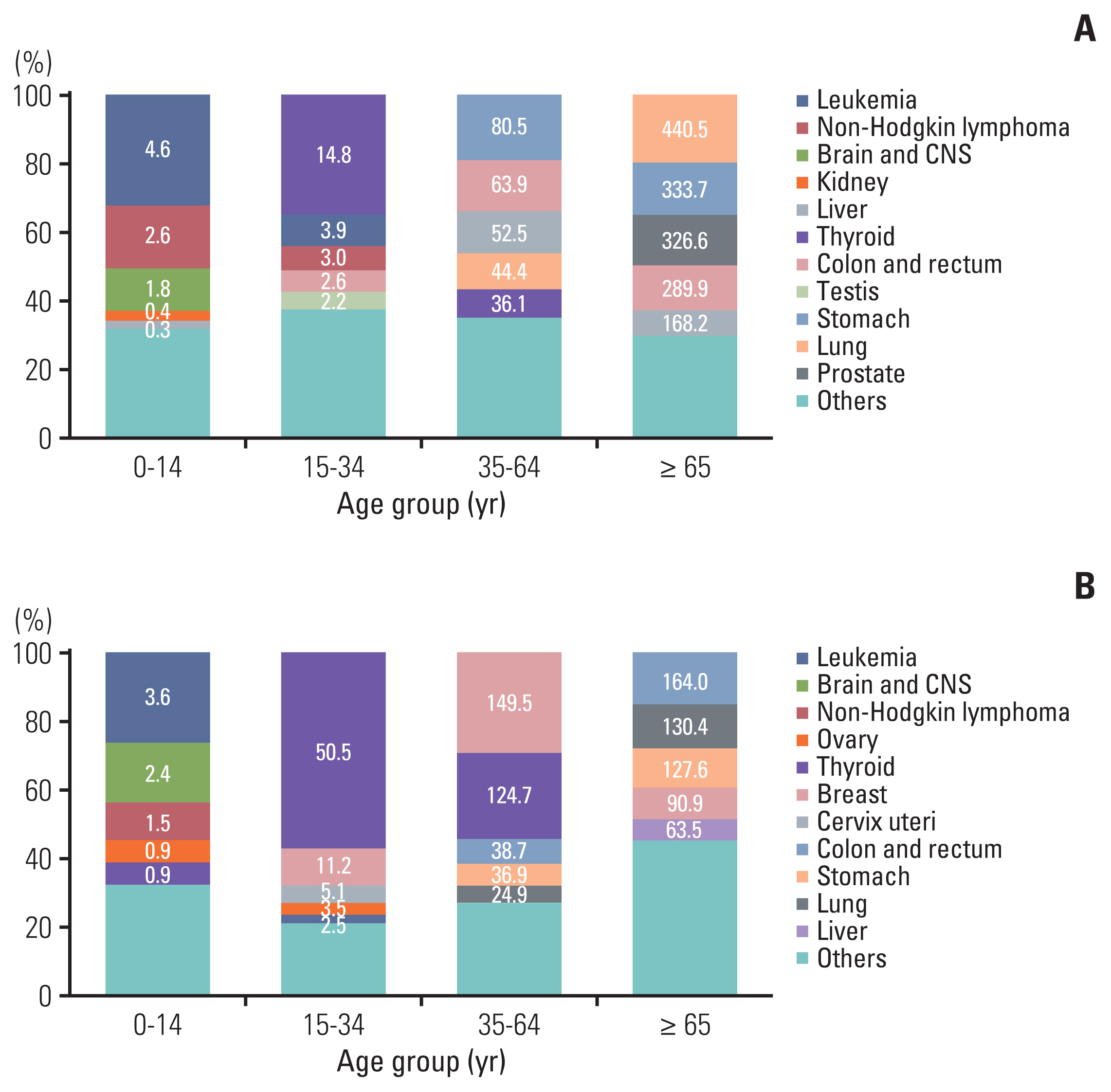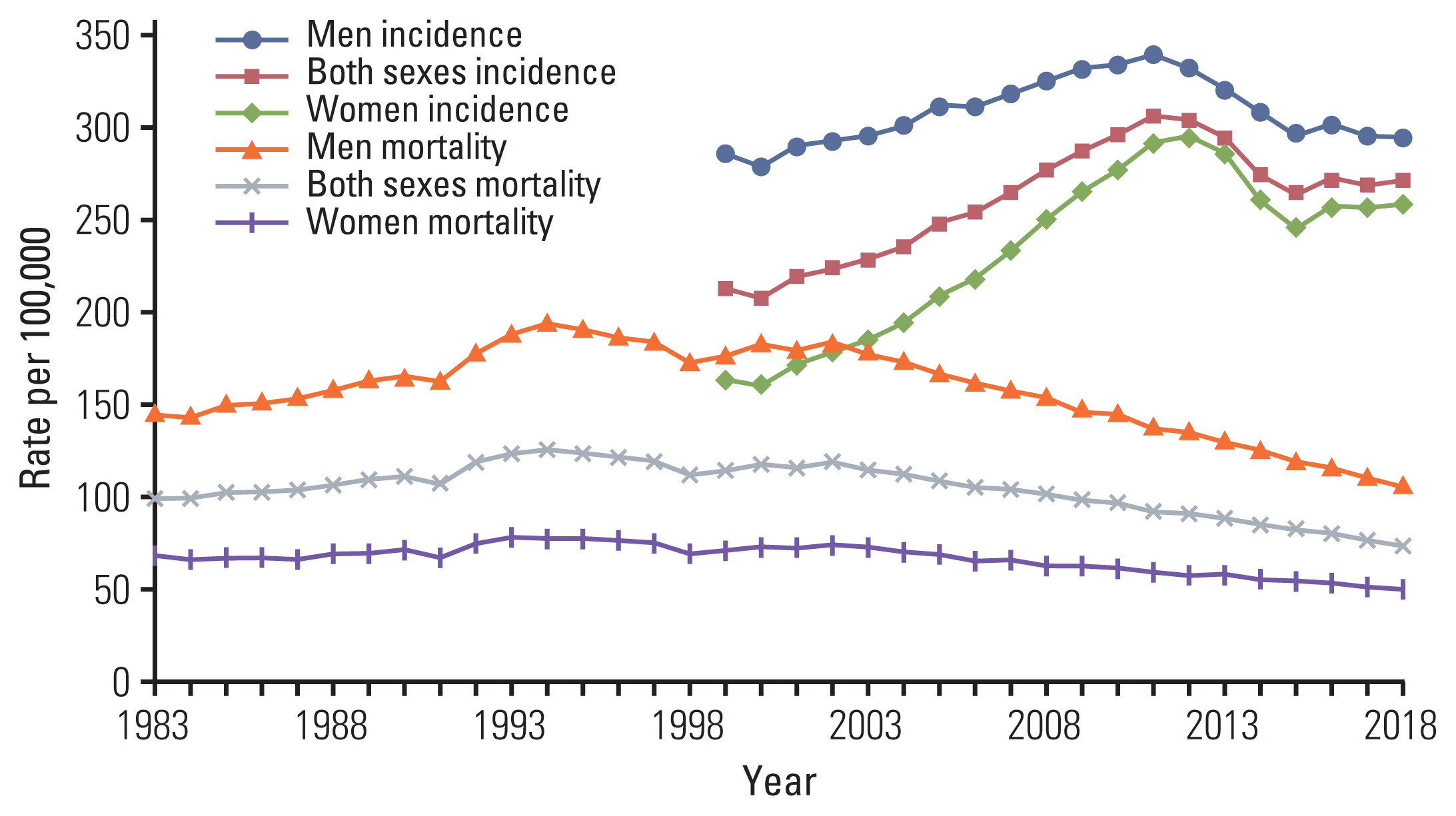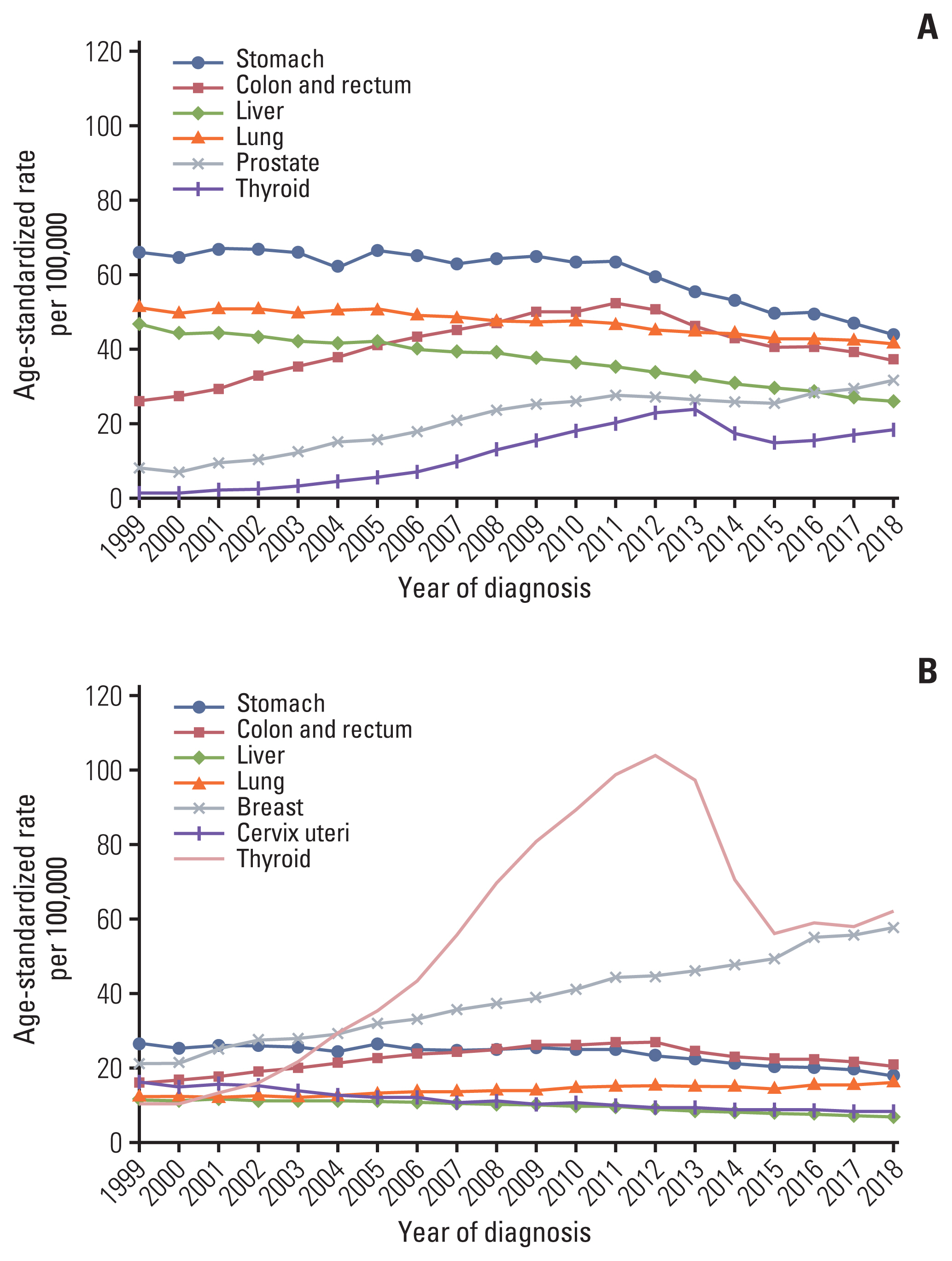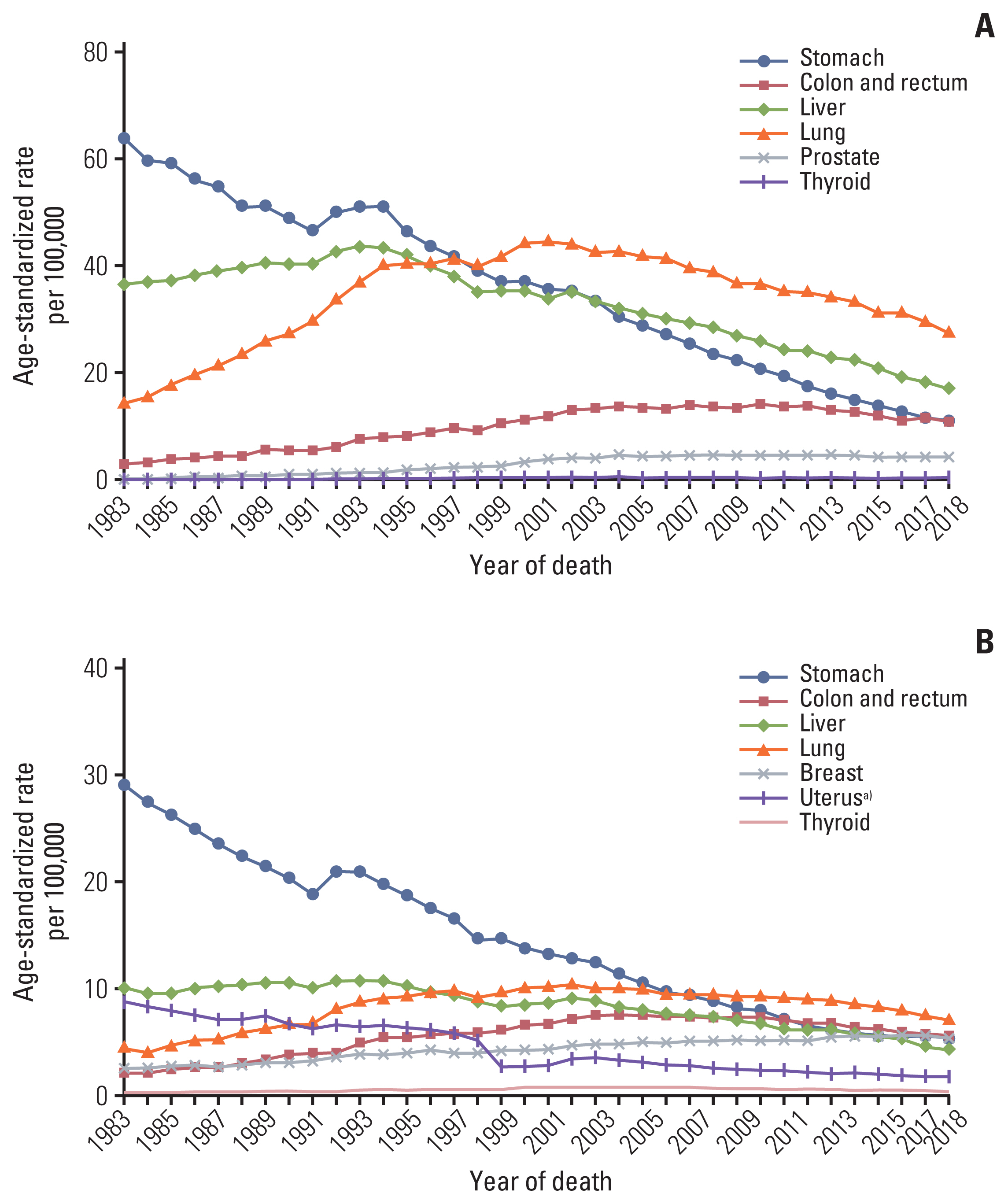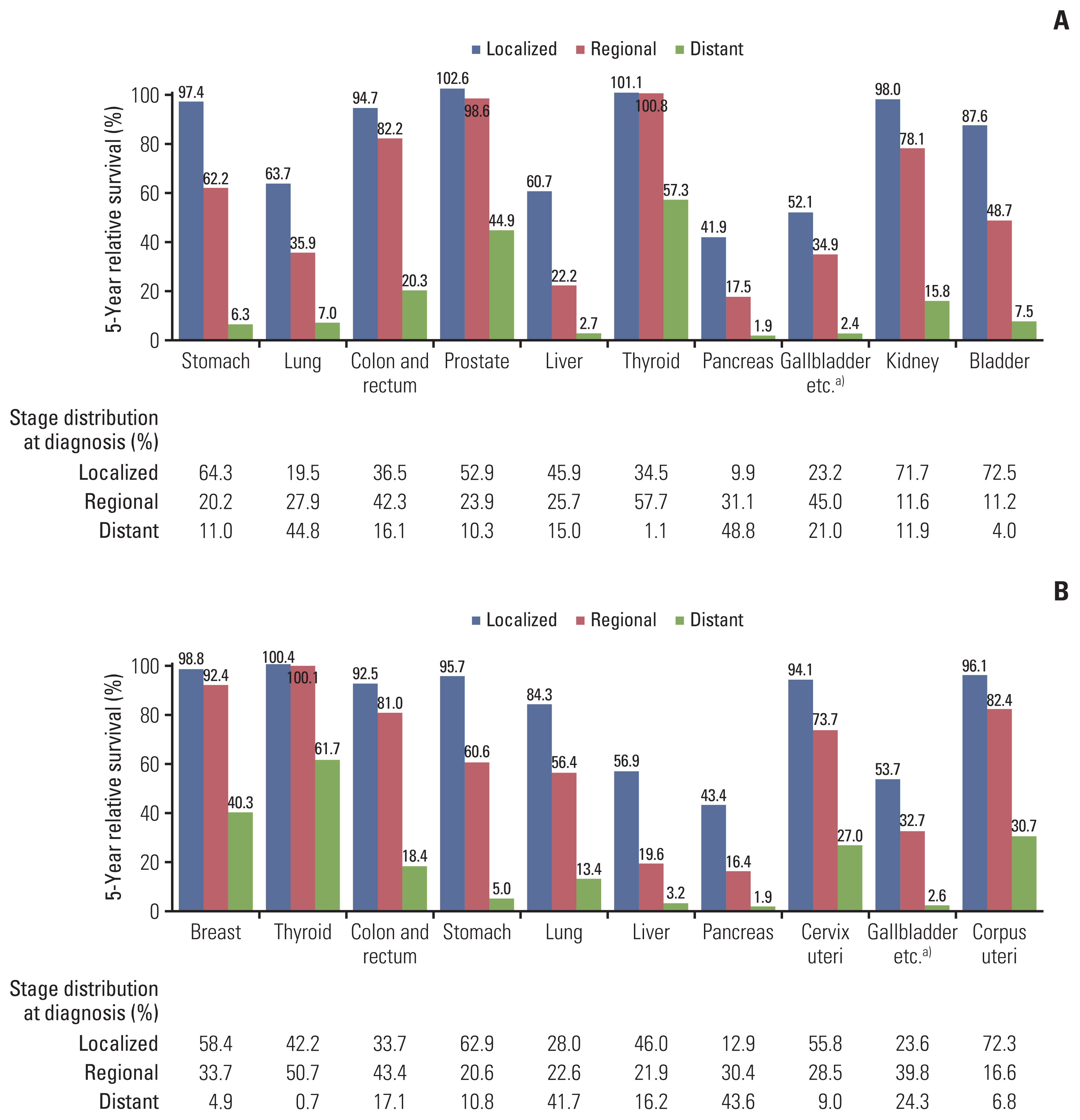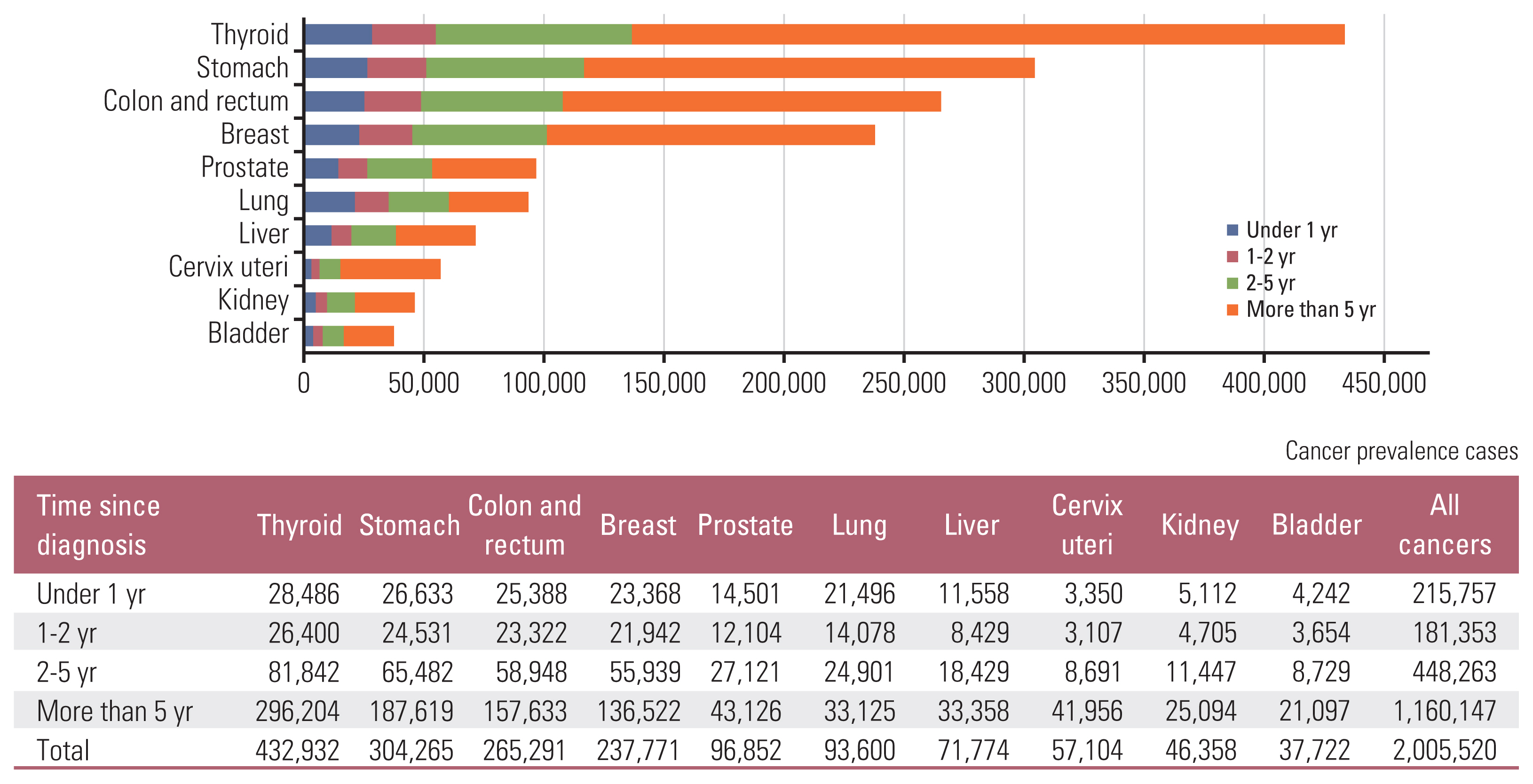Cancer Statistics in Korea: Incidence, Mortality, Survival, and Prevalence in 2018
- Affiliations
-
- 1Korea Central Cancer Registry, National Cancer Center, Goyang, Korea
- 2Division of Cancer Registration and Surveillance, National Cancer Control Institute, National Cancer Center, Goyang, Korea
- 3National Cancer Center Graduate School of Cancer Science and Policy, National Cancer Center, Goyang, Korea
- 4National Cancer Control Institute, National Cancer Center, Goyang, Korea
- KMID: 2514913
- DOI: http://doi.org/10.4143/crt.2021.291
Abstract
- Purpose
The current study provides national cancer statistics and their secular trends in Korea, including incidence, mortality, survival, and prevalence in 2018.
Materials and Methods
Incidence, survival, and prevalence rates of cancer were calculated using the Korea National Cancer Incidence Database, from 1999 to 2018, with survival follow-up until December 31, 2019. Deaths from cancer were assessed using causes-of-death data obtained from Statistics Korea. Crude and age-standardized rates (ASRs) for incidence, mortality, prevalence, and 5-year relative survival rates were calculated, and temporal trends for incidence and mortality rates were evaluated, with annual percentage changes.
Results
In 2018, newly diagnosed cancer cases and deaths from cancer were reported as 243,837 (ASR, 270.4 per 100,000) and 79,153 (ASR, 73.3 per 100,000), respectively. The overall cancer incidence rates increased by 3.3% annually from 1999 to 2012, and decreased by 5.4% annually from 2012 to 2015, thereafter, followed by nonsignificant changes. Cancer mortality rates have been decreasing since 2002, with more rapid decline in recent years (annual decrease of 2.7% from 2007 to 2014; 3.7% from 2014 to 2018). The 5-year relative survival between 2014 and 2018 was 70.3%, which contributed to prevalent cases reaching over 2 million by the end of 2018.
Conclusion
Cancer statistics have improved significantly during the past two decades. However, there remain important challenges to be solved, such as controlling cancers with low survival rates. Cancer statistics can be used to discover blind spots in cancer control, and as evidence for developing and implementing future cancer control strategies.
Figure
Cited by 20 articles
-
Practical issues and research trends of oncofertility in gynecologic cancer
Jeong-Yeol Park
Korean J Women Health Nurs. 2021;27(2):64-68. doi: 10.4069/kjwhn.2021.05.31.Twenty-year incidence trend of hematologic malignancies in the Republic of Korea: 1999‒2018
Won-Ju Park, Joo-Heon Park, Seunghyeon Cho, Myung Geun Shin
Blood Res. 2021;56(4):301-314. doi: 10.5045/br.2021.2021187.An update on immunotherapy with PD-1 and PD-L1 blockade
Sung Ae Koh
Yeungnam Univ J Med. 2021;38(4):308-317. doi: 10.12701/yujm.2021.01312.Effect of National Oral Health Screening Program on the Risk of Head and Neck Cancer: A Korean National Population-Based Study
Chan Woo Wee, Hyo-Jung Lee, Jae-Ryun Lee, Hyejin Lee, Min-Jeong Kwoen, Woo-Jin Jeong, Keun-Yong Eom
Cancer Res Treat. 2022;54(3):709-718. doi: 10.4143/crt.2021.834.Predictive Value of Interstitial Lung Abnormalities for Postoperative Pulmonary Complications in Elderly Patients with Early-Stage Lung Cancer
Won Gi Jeong, Yun-Hyeon Kim, Jong Eun Lee, In-Jae Oh, Sang Yun Song, Kum Ju Chae, Hye Mi Park
Cancer Res Treat. 2022;54(3):744-752. doi: 10.4143/crt.2021.772.Prediction of Cancer Incidence and Mortality in Korea, 2022
Kyu-Won Jung, Young-Joo Won, Mee Joo Kang, Hyun-Joo Kong, Jeong-Soo Im, Hong Gwan Seo
Cancer Res Treat. 2022;54(2):345-351. doi: 10.4143/crt.2022.179.Staging and response assessment of lymphoma: a brief review of the Lugano classification and the role of FDG-PET/CT
Kwai Han Yoo
Blood Res. 2022;57(S1):75-78. doi: 10.5045/br.2022.2022055.Trend Analysis and Prediction of Hepatobiliary Pancreatic Cancer Incidence and Mortality in Korea
Hyeong Min Park, Young-Joo Won, Mee Joo Kang, Sang-Jae Park, Sun-Whe Kim, Kyu-Won Jung, Sung-Sik Han
J Korean Med Sci. 2022;37(28):e216. doi: 10.3346/jkms.2022.37.e216.Recent Changes in the Incidence of Thyroid Cancer in Korea between 2005 and 2018: Analysis of Korean National Data
Yun Mi Choi, Jiwoo Lee, Mi Kyung Kwak, Min Ji Jeon, Tae Yong Kim, Eun-Gyoung Hong, Won Bae Kim, Won Gu Kim
Endocrinol Metab. 2022;37(5):791-799. doi: 10.3803/EnM.2022.1533.Clinical Application of Circulating Tumor DNA Analysis
Dongju Won, Jinho Heo, Hongkyung Kim, Saeam Shin, Seung-Tae Lee
Lab Med Online. 2022;12(4):235-243. doi: 10.47429/lmo.2022.12.4.235.Metformin and Cervical Cancer Risk in Patients with Newly Diagnosed Type 2 Diabetes: A Population-Based Study in Korea
Hyun Min Kim, Min Jin Kang, Sun Ok Song
Endocrinol Metab. 2022;37(6):929-937. doi: 10.3803/EnM.2022.1613.A standardized pathology report for gastric cancer: 2nd edition
Young Soo Park, Myeong-Cherl Kook, Baek-hui Kim, Hye Seung Lee, Dong-Wook Kang, Mi-Jin Gu, Ok Ran Shin, Younghee Choi, Wonae Lee, Hyunki Kim, In Hye Song, Kyoung-Mee Kim, Hee Sung Kim, Guhyun Kang, Do Youn Park, So-Young Jin, Joon Mee Kim, Yoon Jung Choi, Hee Kyung Chang, Soomin Ahn, Mee Soo Chang, Song-Hee Han, Yoonjin Kwak, An Na Seo, Sung Hak Lee, Mee-Yon Cho
J Pathol Transl Med. 2023;57(1):1-27. doi: 10.4132/jptm.2022.12.23.Pancreatoduodenectomy following neoadjuvant chemotherapy in duodenal adenocarcinoma
Dongjin Seo, Bo Gyeom Park, Dawn Jung, Ho Kyoung Hwang, Sung Hyun Kim, Seung Soo Hong, Chang Moo Kang
Ann Hepatobiliary Pancreat Surg. 2023;27(1):114-119. doi: 10.14701/ahbps.22-069.Trends and Patterns of Cancer Burdens by Region and Income Level in Korea: A National Representative Big Data Analysis
Yoon-Sun Jung, Seok-Jun Yoon
Cancer Res Treat. 2023;55(2):408-418. doi: 10.4143/crt.2022.126.Descriptive Analysis of Gastric Cancer Mortality in Korea, 2000–2020
Tung Hoang, Hyeongtaek Woo, Sooyoung Cho, Jeeyoo Lee, Sayada Zartasha Kazmi, Aesun Shin
Cancer Res Treat. 2023;55(2):603-617. doi: 10.4143/crt.2022.307.Real-World Study Evaluating Safety and Effectiveness of Axitinib in Korean Patients with Renal Cell Carcinoma after Failure of One Prior Systemic Therapy
Sang Joon Shin, Jae Lyun Lee, Tae Gyun Kwon, Byoung Young Shim, Ho Seok Chung, Sang-Hee Kim, Se Hoon Park
Cancer Res Treat. 2023;55(2):643-651. doi: 10.4143/crt.2022.883.Recent Trends of Medical Expenses Associated with Radiation Therapy in Korea Based on HIRA Big Data
Jeong Eun Lee, Kyungmi Yang, Yong Chan Ahn, Won Park, Seung Jae Huh
Cancer Res Treat. 2023;55(3):758-765. doi: 10.4143/crt.2022.389.A Phase 3 Randomized Clinical Trial to Compare Efficacy and Safety between Combination Therapy and Monotherapy in Elderly Patients with Advanced Gastric Cancer (KCSG ST13-10)
Keun-Wook Lee, Dae Young Zang, Min-Hee Ryu, Hye Sook Han, Ki Hyang Kim, Mi-Jung Kim, Sung Ae Koh, Sung Sook Lee, Dong-Hoe Koo, Yoon Ho Ko, Byeong Seok Sohn, Jin Won Kim, Jin Hyun Park, Byung-Ho Nam, In Sil Choi
Cancer Res Treat. 2023;55(4):1250-1260. doi: 10.4143/crt.2023.333.Prediction of Cancer Incidence and Mortality in Korea, 2024
Kyu-Won Jung, Mee Joo Kang, Eun Hye Park, E Hwa Yun, Hye-Jin Kim, Jeong-Eun Kim, Hyun-Joo Kong, Jeong-Soo Im, Hong Gwan Seo
Cancer Res Treat. 2024;56(2):372-379. doi: 10.4143/crt.2024.252.Advancing Korean nationwide registry for hepatocellular carcinoma: a systematic sampling approach utilizing the Korea Central Cancer Registry database
Bo Hyun Kim, E Hwa Yun, Jeong-Hoon Lee, Geun Hong, Jun Yong Park, Ju Hyun Shim, Eunyang Kim, Hyun-Joo Kong, Kyu-Won Jung, Young-Suk Lim
J Liver Cancer. 2024;24(1):57-61. doi: 10.17998/jlc.2024.03.03.
Reference
-
References
1. Sung H, Ferlay J, Siegel RL, Laversanne M, Soerjomataram I, Jemal A, et al. Global cancer statistics 2020: GLOBOCAN estimates of incidence and mortality worldwide for 36 cancers in 185 countries. CA Cancer J Clin. 2021. Feb. 4. [Epub]. https://doi.org/10.3322/caac.21660 .
Article2. World Health Organization. WHO report on cancer: setting priorities, investing wisely and providing care for all. Geneva: World Health Organization;2020.3. Shin HR, Won YJ, Jung KW, Kong HJ, Yim SH, Lee JK, et al. Nationwide cancer incidence in Korea, 1999–2001: first result using the national cancer incidence database. Cancer Res Treat. 2005; 37:325–31.
Article4. Ajiki W, Tsukuma H, Oshima A. Index for evaluating completeness of registration in population-based cancer registries and estimation of registration rate at the Osaka Cancer Registry between 1966 and 1992 using this index. Nihon Koshu Eisei Zasshi. 1998; 45:1011–7.5. Statistics Korea [Internet]. Daejeon: Statistics Korea;2019. [cited 2021 Feb 28]. Available from: http://kosis.kr .6. Fritz A, Percy C, Jack A, Shanmugaratnam K, Sobin L, Parkin DM, et al. International classification of diseases for oncology. 3rd ed. 1st rev. Geneva: World Health Organization;2013.7. World Health Organization. International statistical classification of diseases and related health problems. 10th rev. Geneva: World Health Organization;1994.8. Ferlay J, Ervik M, Lam F, Colombet M, Mery L, Piñeros M, et al. Global cancer observatory: cancer today – data and methods [Internet]. Lyon: International Agency for Research on Cancer;2020. [cited 2021 Feb 28]. Available from: https://gco.iarc.fr/today/data-sources-methods .9. Cancer incidence in five continents, Vol. XI. Chapter 3. Classification and coding [Internet]. Lyon: International Agency for Research on Cancer;2020. [cited 2021 Feb 28]. Available from: http://ci5.iarc.fr/CI5-XI/Pages/Chapter3.aspx .10. Young JL Jr, Roffers SD, Ries LA, Fritz AG, Hurlbut AA. SEER summary staging manual 2000: codes and coding instructions. National Cancer Institute, NIH Pub. No. 01-4969. Bethesda, MD: National Cancer Institute;2001.11. Cancer incidence in five continents, Vol. XI. Chapter 7 Age standardization [Internet]. Lyon: International Agency for Research on Cancer;2020. [cited 2021 Feb 28]. Available from: http://ci5.iarc.fr/CI5-XI/Pages/Chapter7.aspx .12. Segi M. Cancer mortality for selected sites in 24 countries 1950–1957. Sendai: Tohoku University School of Medicine;1960.13. Surveillance Research Program Joinpoint Regression Program, version 4801 [Internet]. Bethesda, MD: Surveillance Research Program, National Cancer Institute;2020. [cited 2020 Dec 1]. Available from: https://surveillance.cancer.gov/joinpoint/ .14. Ederer F, Heise H. Instructions to IBM 650 programmers in processing survival computations. Methodological note, No. 10. Bethesda, MD: National Cancer Institute;1959.15. Paul Dickman [Internet]. Stockholm: PaulDickman.com;2016. [cited 2021 Feb 28]. Available from: http://www.pauldickman.com .
- Full Text Links
- Actions
-
Cited
- CITED
-
- Close
- Share
- Similar articles
-
- Cancer Statistics in Korea: Incidence, Mortality, Survival, and Prevalence in 2008
- Cancer Statistics in Korea: Incidence, Mortality, Survival, and Prevalence in 2015
- Cancer Statistics in Korea: Incidence, Mortality, Survival, andPrevalence in 2017
- Cancer Statistics in Korea: Incidence, Mortality, Survival, and Prevalence in 2016
- Cancer Statistics in Korea: Incidence, Mortality, Survival, and Prevalence in 2014

